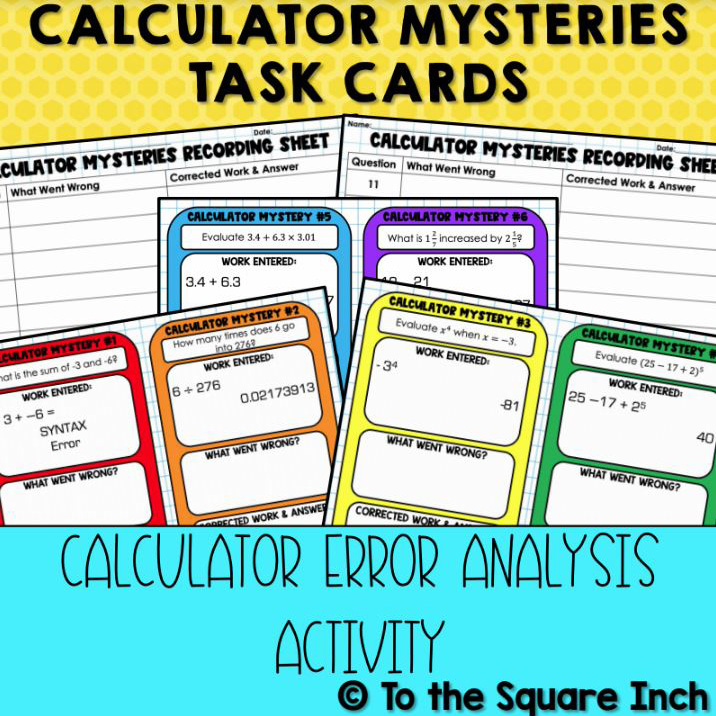Why It’s Good to Make Mistakes in Math Class
If you’re a math teacher, you’re familiar with students anxiously asking to use their calculators. For them, it may feel like a secret weapon that will help them be more successful in math class.
Throughout elementary school, kids trudge through adding fractions, multiplying five-digit numbers and dividing decimals by decimals. For most students, middle school is their first opportunity to use a calculator, and everyone can likely remember how excited they were when they first got to use them. But you know as well as I do, while the kids may think they now have all the answers at their fingertips, that’s a myth.
Students often use their calculators incorrectly and usually have no idea why their answer is wrong. Inevitably, they end up raising their hands during tests with profound questions. The answer the calculator gave them isn’t an answer choice. So much for being the secret weapon! The reality is that many students lack the mathematical understanding needed to solve problems and, as a result, make conceptual errors even with the help of a calculator for computations.
I find it helpful to let students explore their calculators without giving them any instructions on how to use it. Most students can use a simple four-function variety, but rarely do they have experience with scientific calculators. Giving them time to explore and experiment helps them understand how powerful of a tool it really is. I give a few simple questions on the board and have my students use their calculators to find the answers. It helps to mix it up, so I try to include questions that use decimal operations, fraction operations, exponents and order of operations. Students then share their answers with their tables, discuss which answer is correct and, if necessary, figure out why some students got an incorrect answer.
After students have had an ample amount of time to explore, I then go over how to actually use the calculator. As we push past the four basic functions, I like to have them complete specific error-analysis tasks pertaining to calculator use. Using a set of 20 Calculator Mysteries Task Cards, I have students look at each problem, analyze the work specifically entered into the calculator, and identify the error and how to correct it. Then, I ask them to find the correct answer while letting students work with their classmates on these tasks. Allowing them to discuss and defend helps them remember their findings for the future.

I always tell my students, “A calculator only knows as much as the person using it.” It is so important for students to embrace this mantra. A calculator is a powerful tool used for problem-solving, but it’s not a secret weapon that will keep them from ever having to think about math again. Rather, it should empower them to take on deeper and more challenging problems.

About the author: Kate Bing Coners is a sixth grade math teacher on Long Island, New York. She loves creating and sharing engaging middle school math activities on her website, To the Square Inch, and on Instagram (@tothesquareinch).
Tagcloud
Archive
- 2025
- 2024
- 2023
- 2022
-
2021
- January (2)
- February (3)
- March (5)
-
April (7)
- Top Tips for Tackling the SAT® with the TI-84 Plus CE
- Monday Night Calculus With Steve Kokoska and Tom Dick
- Which TI Calculator for the SAT® and Why?
- Top Tips From a Math Teacher for Taking the Online AP® Exam
- Celebrate National Robotics Week With Supervised Teardowns
- How To Use the TI-84 Plus Family of Graphing Calculators To Succeed on the ACT®
- AP® Statistics: 6 Math Functions You Must Know for the TI-84 Plus
- May (1)
- June (3)
- July (2)
- August (5)
- September (2)
-
October (4)
- Transformation Graphing — the Families of Functions Modular Video Series to the Rescue!
- Top 3 Halloween-Themed Classroom Activities
- In Honor of National Chemistry Week, 5 “Organic” Ways to Incorporate TI Technology Into Chemistry Class
- 5 Spook-tacular Ways to Bring the Halloween “Spirits” Into Your Classroom
- November (4)
- December (1)
-
2020
- January (2)
- February (1)
- March (3)
- April (1)
- May (2)
- July (1)
- August (2)
- September (3)
-
October (7)
- Tips for Teachers in the time of COVID-19
- Top 10 Features of TI-84 Plus for Taking the ACT®
- TI Codes Contest Winners Revealed
- Best of Chemistry Activities for the Fall Semester
- Best of Biology Activities for the Fall Semester
- Best of Physics Activities for the Fall Semester
- Best of Middle Grades Science Activities
- November (1)
- December (2)
- 2019
-
2018
- January (1)
- February (5)
- March (4)
- April (5)
- May (4)
- June (4)
- July (4)
- August (4)
- September (5)
-
October (9)
- Art in Chemistry
- Which Texas Instruments (TI) Calculator for the ACT® and Why?
- Meet TI Teacher of the Month: Jessica Kohout
- Innovation in Biology
- Learning With Your Students
- A first-of-its-kind STEM strategy charts path to help educators
- #NCTMregionals Hartford 2018 Recap
- The Math Behind “Going Viral”
- Real-World Applications of Chemistry
-
November (8)
- Testing Tips: Using Calculators on Class Assessments
- Girls in STEM: A Personal Perspective
- 5 Teachers You Should Be Following on Instagram Right Now
- Meet TI Teacher of the Month: Katie England
- End-of-Marking Period Feedback Is a Two-Way Street
- #NCTMregionals Kansas City 2018 Recap
- Slope: It Shouldn’t Just Be a Formula
- Hit a high note exploring the math behind music
- December (5)
- 2017
- 2016
- 2015
